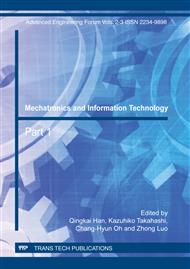[1]
H. Seki, K. Ishihara and S. Tadakuma, "Novel regenerative braking control of electric power-assisted wheelchair for safety downhill road driving," IEEE Trans. on Industrial Electronics, Vol. 56, No. 5,2009, pp.1393-1400.
DOI: 10.1109/tie.2009.2014747
Google Scholar
[2]
S. Tashiro and T. Murakami, "Step passage control of a power-assisted wheelchair for a caregiver," IEEE Trans. on Industrial Electronics, Vol. 55, No. 4, April 2008, pp.1715-1721.
DOI: 10.1109/tie.2008.917061
Google Scholar
[3]
S.M.M. Rahman, R. Ikeura, M. Nobe, S. Hayakawa, H. Sawai, "Weight-perception-based model of power assist system for lifting objects," Int. Journal of Automation Technology, Vol.3, No.6, pp.681-691, Nov 2009.
DOI: 10.20965/ijat.2009.p0681
Google Scholar
[4]
T.Doi, H. Yamada, T. Ikemoto, and H. Naratani, "Simulation of a pneumatic hand crane power-assist system," Journal of Robotics and Mechatronics, Vol.20, No.6, 2008, pp.896-902.
DOI: 10.1109/sice.2007.4421376
Google Scholar
[5]
A. Niinuma, T.Miyoshi, K. Terashima, Y. Miyashita, "Evaluation of effectiveness of a power-assisted wire suspension system compared to conventional machine," in Proc. of 2009 IEEE Int. Conf. on Mechatronics and Automation, Aug. 9-12, 2009, pp.369-374.
DOI: 10.1109/icma.2009.5246728
Google Scholar
[6]
S.M.M. Rahman, R. Ikeura, H. Sawai, "Design and control of a power-assist robot system for lifting objects based on human's unimanual and bimanual weight discrimination," International Journal of Assistive Robotics and Systems,Vol.11, No.2, pp.11-29, June 2010.
DOI: 10.1109/icma.2009.5246450
Google Scholar
[7]
S.M.M. Rahman, R. Ikeura, S. Hayakawa, and H. Sawai, "Design guidelines for power assist robots for lifting heavy objects considering weight perception, grasp differences and worst-cases," International Journal of Mechatronics and Automation, Vol. 1, No. 1, p.46–59, March 2011.
DOI: 10.1504/ijma.2011.039155
Google Scholar
[8]
S.M.M. Rahman, R. Ikeura, S. Hayakawa, H. Sawai, "Design and control of a power assist system for lifting objects based on human operator's weight perception and load force characteristics," IEEE Transactions on Industrial Electronics, Vol.58, No.8,pp.3141-3150, August 2011.
DOI: 10.1109/tie.2010.2087291
Google Scholar
[9]
S.M.M. Rahman, R. Ikeura, M. Nobe, H. Sawai, "Study on optimum maneuverability in horizontal manipulation of objects with power-assist based on weight perception," in Proceedings of SPIE, Vol. 7500, 75000P (2010).
DOI: 10.1117/12.858442
Google Scholar


